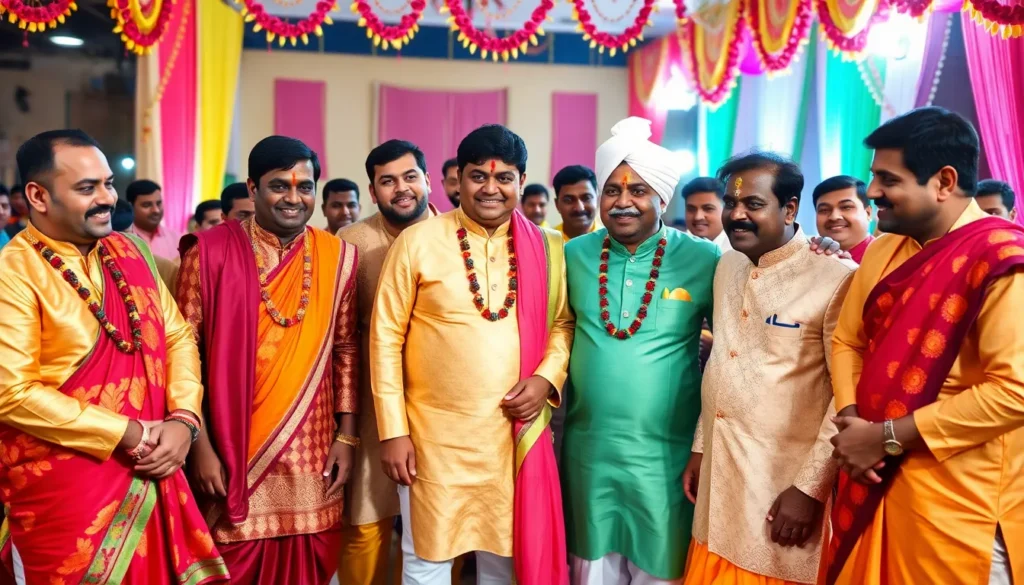Indian traditional wear for men represents centuries of rich cultural heritage and timeless elegance that continues to captivate fashion enthusiasts worldwide. From the regal kurta-pajama to the sophisticated dhoti and the versatile sherwani, these garments tell stories of ancient traditions while seamlessly blending with modern style sensibilities.
We’ve witnessed a remarkable resurgence of traditional Indian menswear in recent years as men increasingly embrace their cultural roots. Whether you’re attending a wedding ceremony, celebrating festivals, or simply wanting to honor your heritage, understanding the variety of traditional outfits available can transform your wardrobe and boost your confidence.
The beauty of Indian traditional wear lies in its incredible diversity—each region offers unique styles, fabrics, and embellishments that reflect local customs and craftsmanship. From the flowing elegance of South Indian mundus to the structured sophistication of North Indian achkans, there’s a traditional outfit that perfectly matches every man’s personality and occasion.
Dhoti: The Timeless Traditional Garment
The dhoti stands as India’s most ancient and revered garment for men, representing thousands of years of cultural heritage. We consider it the foundation of traditional Indian menswear that continues to hold deep spiritual and cultural significance across the subcontinent.
Origins and Cultural Significance
Ancient scriptures and historical texts trace the dhoti’s origins back over 5,000 years to the Indus Valley Civilization. Archaeological evidence from Harappa and Mohenjo-daro shows men wearing draped lower garments similar to modern dhotis, establishing its place as one of humanity’s oldest clothing traditions.
Religious texts like the Vedas and Puranas frequently mention the dhoti as sacred attire worn by gods, sages, and kings. Hindu mythology depicts Lord Krishna, Lord Rama, and other deities adorned in elegant dhotis, cementing its spiritual importance in Indian culture.
Regional variations developed over centuries as different communities adapted the garment to their local customs and climate. Bengali dhotis traditionally feature red borders symbolizing prosperity, while South Indian variants often include gold threads representing divine blessings.
Different Draping Styles Across Regions
Bengali style draping creates the classic “fish tail” appearance by pleating the fabric between the legs and tucking it at the back waist. This method produces a distinctive silhouette that’s both comfortable and visually striking for formal occasions.
Maharashtrian dhoti draping involves creating a shorter length that ends above the ankles, allowing for greater mobility during traditional dances like Lavani. The fabric gets wrapped around the waist twice before securing the pleated section at the front.
South Indian communities prefer the “Pancha” style, where the dhoti extends to full ankle length with minimal pleating. This draping method emphasizes the fabric’s natural flow and works exceptionally well with silk materials featuring intricate borders.
Tamil Nadu’s traditional style incorporates the “Veshti” technique, creating angular pleats that form a structured appearance. The fabric gets folded in a exact pattern that creates visual interest while maintaining the garment’s sacred geometry.
When and Where to Wear a Dhoti
Religious ceremonies and temple visits represent the most traditional occasions for dhoti wearing, as many temples require devotees to wear traditional attire. We recommend choosing cotton or silk dhotis for these spiritual gatherings, depending on the ceremony’s formality level.
Wedding celebrations across India feature grooms and male relatives wearing ornate silk dhotis with gold borders and intricate embroidery. These special occasion dhotis often cost between $50 to $500, depending on the silk quality and craftsmanship involved.
Festival celebrations like Diwali, Durga Puja, and Ganesh Chaturthi provide perfect opportunities to showcase regional dhoti styles. Cultural performances, classical dance recitals, and traditional music concerts also call for authentic dhoti attire.
Modern fashion shows and cultural exhibitions increasingly feature contemporary dhoti interpretations, blending traditional draping with modern fabrics and cuts. Fashion designers now create fusion wear that incorporates dhoti elements into pants, shorts, and even formal wear.
Kurta: The Versatile Indian Shirt for Every Occasion
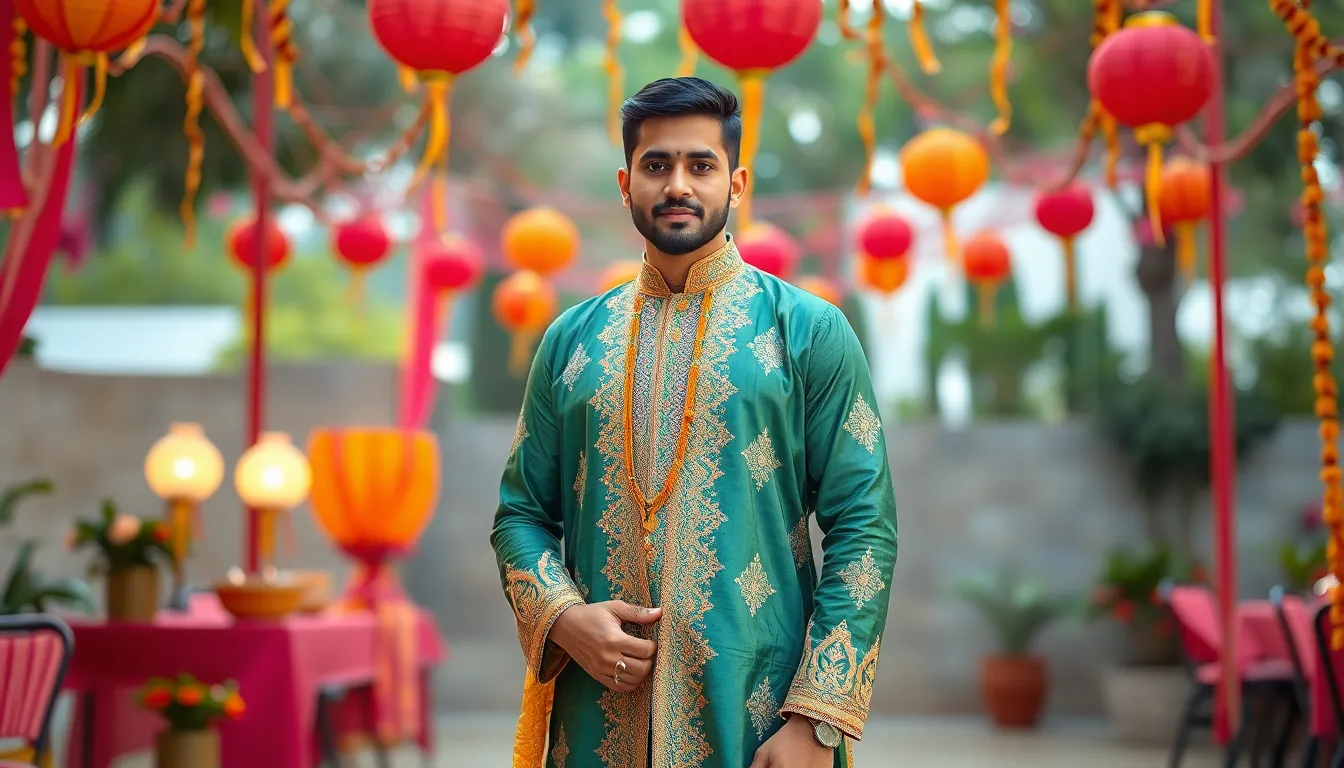
We consider the kurta as the cornerstone of traditional Indian menswear, offering unmatched versatility that seamlessly transitions from casual daily wear to formal celebrations. This loose-fitting tunic extends from knee-length to mid-thigh and serves as our go-to choice for comfort and elegance across diverse occasions.
Short Kurta vs Long Kurta Styles
Short kurtas typically fall at hip-length and provide our preferred option for casual settings where modern aesthetics meet traditional charm. We pair these contemporary pieces with jeans, chinos, or trousers to achieve a semi-casual look that works perfectly for everyday wear. Cotton and linen fabrics dominate this style category, offering breathability and comfort throughout regular activities.
Long kurtas extend below the knee and represent our more formal approach to traditional dressing. We choose these elegant pieces for weddings, religious ceremonies, and festive celebrations where traditional authenticity matters most. Rich fabrics such as silk and brocade with elaborate embellishments characterize these formal kurtas, creating the sophisticated appearance we need for special occasions.
Fabric Choices and Seasonal Variations
Summer selections focus on cotton and linen kurtas in light colors like ivory, beige, and lemon yellow that we rely on for their exceptional breathability. These natural fabrics help us maintain comfort during warmer months while preserving the traditional aesthetic we value.
Winter and special occasion options include silk, brocade, and cotton-silk blends that we prefer for their richness and warmth. Heavier fabrics with ornate details elevate our formal appearance, while the additional weight provides comfort during cooler seasons and ceremonial events.
Pairing Options with Different Bottoms
Pajama pants serve as our traditional loose drawstring trousers that create the classic kurta combination we recognize from cultural heritage. We choose this pairing for authentic traditional appearances and comfortable daily wear.
Churidar pants offer tightly fitting trousers that gather near the ankle, which we select specifically for longer kurtas during weddings and formal ceremonies. This combination provides the refined silhouette we need for sophisticated occasions.
Jeans and chinos represent our contemporary fusion approach, pairing perfectly with short kurtas to create modern casual looks. We embrace this styling when blending traditional elements with contemporary fashion sensibilities.
Dhotis and linen pants provide alternative options that we consider for both traditional and fusion styling, depending on the exact occasion and personal preference. These choices allow us to customize our appearance while maintaining cultural authenticity.
Sherwani: The Regal Wedding Attire
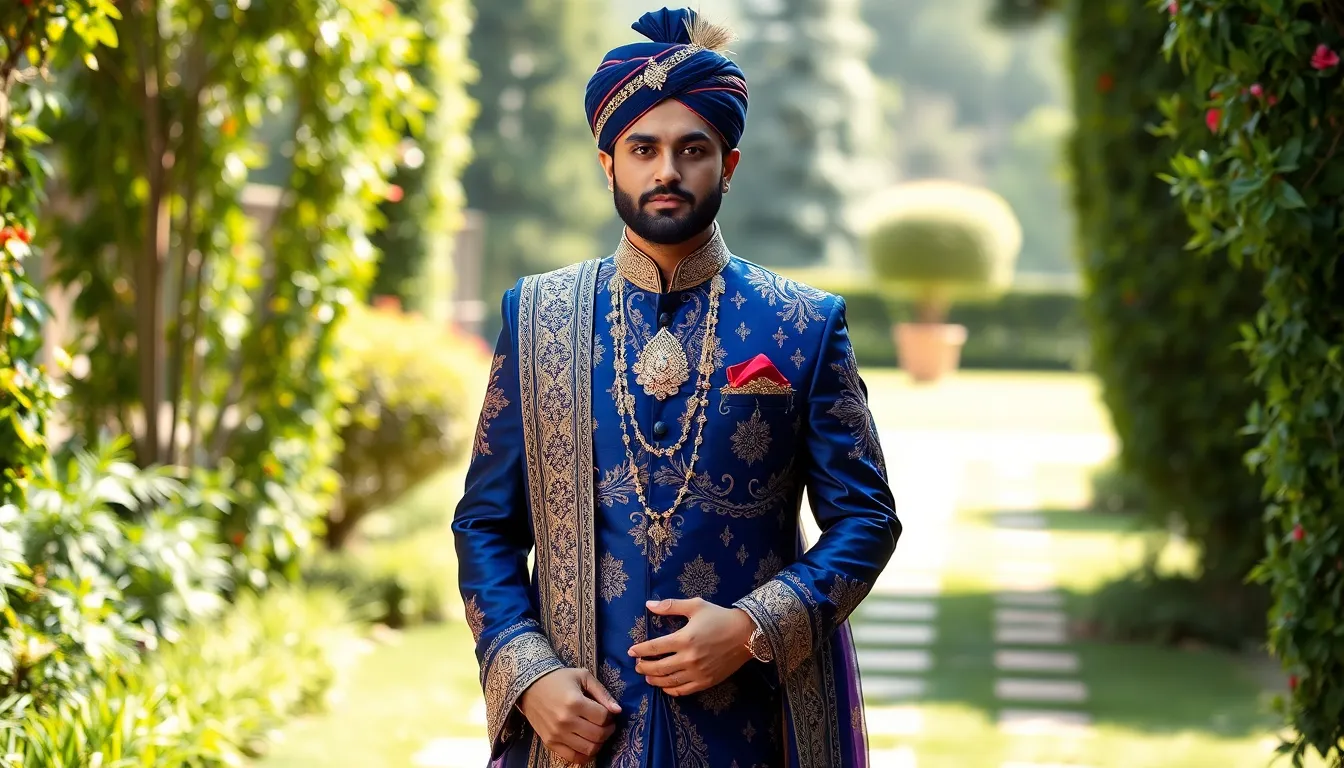
Building on the versatility of kurtas, the sherwani stands as the ultimate expression of Indian menswear elegance. This long coat-like garment extends below the knee and features a distinctive mandarin collar called a bandhgala, creating an unmistakably regal silhouette that has made it the preferred choice for Indian grooms.
Design Elements and Embellishments
Luxurious fabrics form the foundation of every exceptional sherwani, with silk leading the selection for its rich texture and drape. Hand embroidery transforms these garments into masterpieces, featuring intricate patterns that can either complement or artfully contrast with the bride’s outfit.
Zari work adds golden threads that catch light beautifully during wedding ceremonies, while beads and sequins create stunning focal points across the chest and sleeves. Thread embroidery showcases regional craftsmanship, with each technique telling a story of local artistic traditions passed down through generations.
Modern interpretations blend traditional designs with contemporary elements, creating Indo-western silhouettes that appeal to today’s fashion-conscious grooms. These updated versions maintain cultural authenticity while incorporating fresh styling details that feel current and sophisticated.
Choosing the Right Fit and Length
Knee-length proportions define the classic sherwani silhouette, though some designs extend slightly longer to enhance the wearer’s stature. The garment should fit snugly against the body to create that essential regal appearance that makes sherwanis so commanding.
Slim-fit designs have gained tremendous popularity, particularly in Pakistani-style sherwanis that feature designed borders at the collar and sleeves. These customized cuts create clean lines that flatter most body types while maintaining the traditional elegance expected from formal Indian menswear.
Proper tailoring becomes crucial since the sherwani’s impact depends entirely on achieving the perfect fit. We recommend professional alterations to ensure the garment drapes correctly and creates the distinguished look that makes sherwanis perfect for weddings and special ceremonies.
Accessories to Complete the Look
Safas or turbans serve as the crowning element of the sherwani ensemble, adding ornate grandeur that elevates the groom’s overall appearance. These traditional headpieces come in various styles and colors to match different regional preferences and personal tastes.
Stoles and dupattas drape elegantly around the shoulders, providing both visual interest and cultural authenticity to the complete outfit. The flowing fabric creates graceful movement that enhances the sherwani’s majestic presence during wedding processions and ceremonies.
Mojaris represent the perfect footwear choice, often crafted from the same fabric as the sherwani with matching embroidery details. These traditional shoes harmonize beautifully with the outfit while providing comfort during long wedding celebrations, ensuring the groom looks polished from head to toe.
Lungi: The Comfortable South Indian Wrap
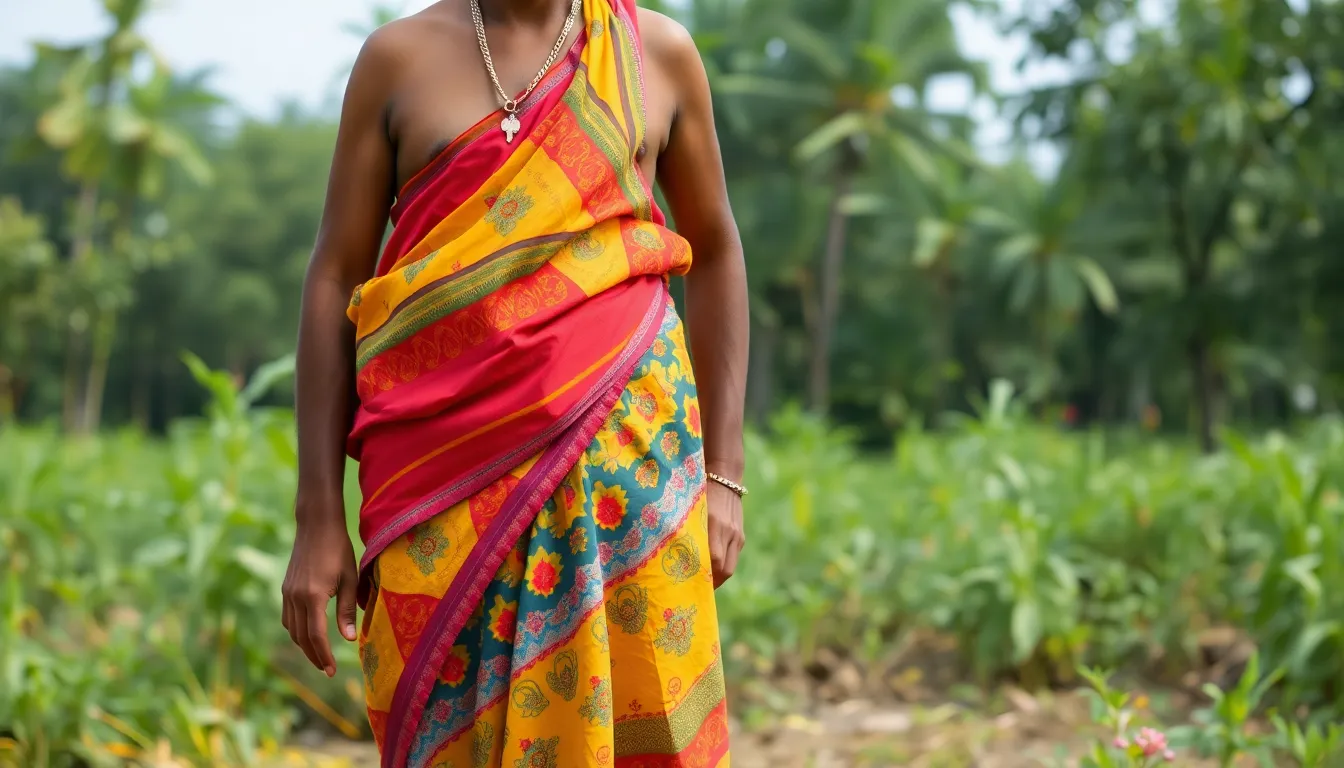
After exploring the elegant sherwanis and versatile kurtas of Indian menswear, we turn our attention to one of South India’s most beloved traditional garments. The lungi stands out as a comfortable wrap skirt made primarily of cotton, tied around the lower waist below the navel for optimal breathability in hot climates.
Regional Variations Across South India
Different states across South India showcase unique lungi preferences that reflect local cultural traditions. Tamil Nadu favors bold multicolored patterns with geometric designs, while Karnataka prefers subtle plaid arrangements in earthy tones. Kerala showcases distinctive border patterns called “kara” that add decorative elements to plain fabrics.
Blue lungis dominate the regional market due to their aesthetic fading properties that create appealing vintage looks over time. Andhra Pradesh and Telangana regions favor darker shades with contrasting borders, while coastal areas prefer lighter colors that reflect heat effectively.
Fabric quality varies significantly between regions, with some areas producing premium handwoven cotton while others focus on machine made alternatives. Manufacturing centers in Coimbatore and Salem produce tube shaped lungis, whereas traditional weavers in rural areas create open cloth variants of identical dimensions.
Casual vs Formal Lungi Styles
Casual lungis serve as everyday comfort wear for home use and informal settings throughout South India. These cotton variants feature vibrant multicolored patterns and provide excellent airflow for nightwear and lounging activities.
Formal lungis elevate traditional occasions with silk fabrics and intricate designs reserved for weddings and ceremonial events. These premium versions showcase elaborate border work, gold thread embellishments, and rich colors that complement traditional shirts and accessories.
Silk lungis command respect at religious ceremonies and cultural festivals, often featuring temple motifs and traditional patterns passed down through generations. Wedding lungis incorporate zari work and decorative elements that match the groom’s overall ensemble coordination.
Proper Wearing Techniques
Tying the lungi requires exact folding methods that ensure secure placement around the waist without restricting movement. Traditional techniques involve creating neat pleats at the front while maintaining smooth fabric distribution around the hips.
Adjusting the length depends on the occasion and personal comfort preferences, with shorter lengths preferred for active tasks and longer draping chosen for formal appearances. Professional demonstrations show various knotting styles that prevent unwrapping during daily activities.
Mobility considerations influence wearing styles as different folding techniques allow easy walking, sitting, and working motions. Expert wearers recommend practicing the tucking method that creates a sophisticated appearance while maintaining the garment’s practical benefits for South Indian climates.
Bandhgala: The Distinguished Formal Jacket
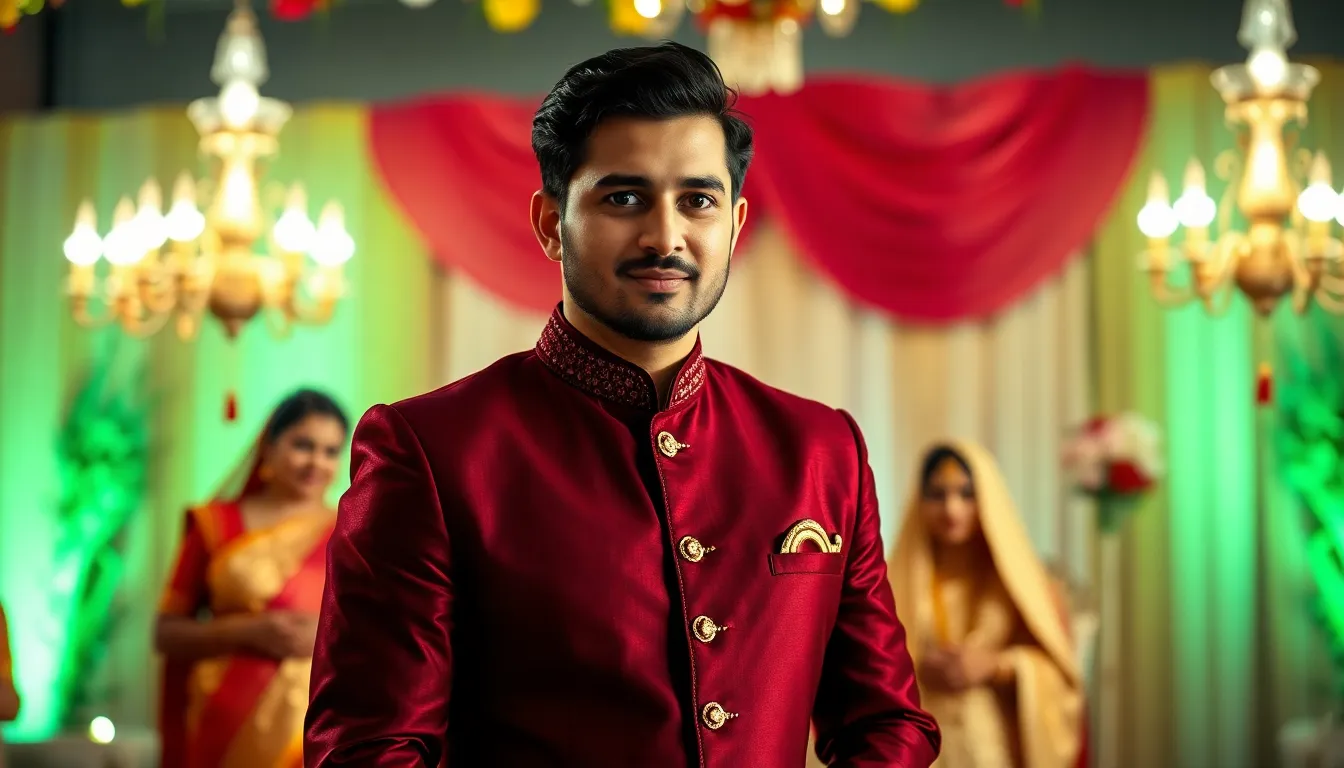
The Bandhgala stands as India’s most sophisticated formal jacket, embodying royal heritage with its distinguished design elements. This Jodhpuri suit emerged during the British colonial era, masterfully blending British tailoring techniques with traditional Indian aesthetics.
Nehru Collar Design Features
Closed stand-up collar defines the Bandhgala’s most recognizable feature, creating an elegant neckline that sets it apart from typical western suits. This mandarin collar design elongates the neck while adding sophistication to the wearer’s profile. Vertical button lines run from collar to waist, creating visual appeal through sleek detailing that flatters the body’s natural contours. Customized fit construction ensures the jacket hugs the wearer’s body precisely, improving the regal appearance through custom fitting that elevates overall style.
Color Combinations and Patterns
Deep maroon selections dominate wedding ceremonies, evoking royal traditions and ceremonial grandeur perfect for matrimonial celebrations. Rich luxurious hues characterize the Bandhgala’s color palette, with sophisticated fabric choices amplifying the garment’s inherent elegance. Darker shade variations include navy blues and charcoal grays that maintain formality while offering versatility across different events. Vibrant pattern options add aesthetic charm through carefully selected designs that complement the jacket’s refined structure without overwhelming its classic silhouette.
| Color Category | Popular Choices | Best Occasions |
|---|---|---|
| Traditional | Deep Maroon, Royal Blue | Weddings, Religious Ceremonies |
| Formal | Navy, Charcoal Gray | Business Events, Receptions |
| Contemporary | Burgundy, Forest Green | Cultural Programs, Festivals |
Occasions Perfect for Bandhgala
Wedding ceremonies showcase the Bandhgala’s finest expression, where grooms and guests alike embrace its distinguished formality for matrimonial celebrations. Reception events benefit from the jacket’s versatile elegance, allowing wearers to maintain sophistication throughout extended social gatherings. Cultural ceremonies highlight the garment’s traditional roots while demonstrating its adaptability to various Indian festivals and religious observances. Special occasions demand the Bandhgala’s refined presence, making it the quintessential choice for events requiring both formal attire and cultural authenticity.
Angrakha: The Cross-Over Traditional Tunic
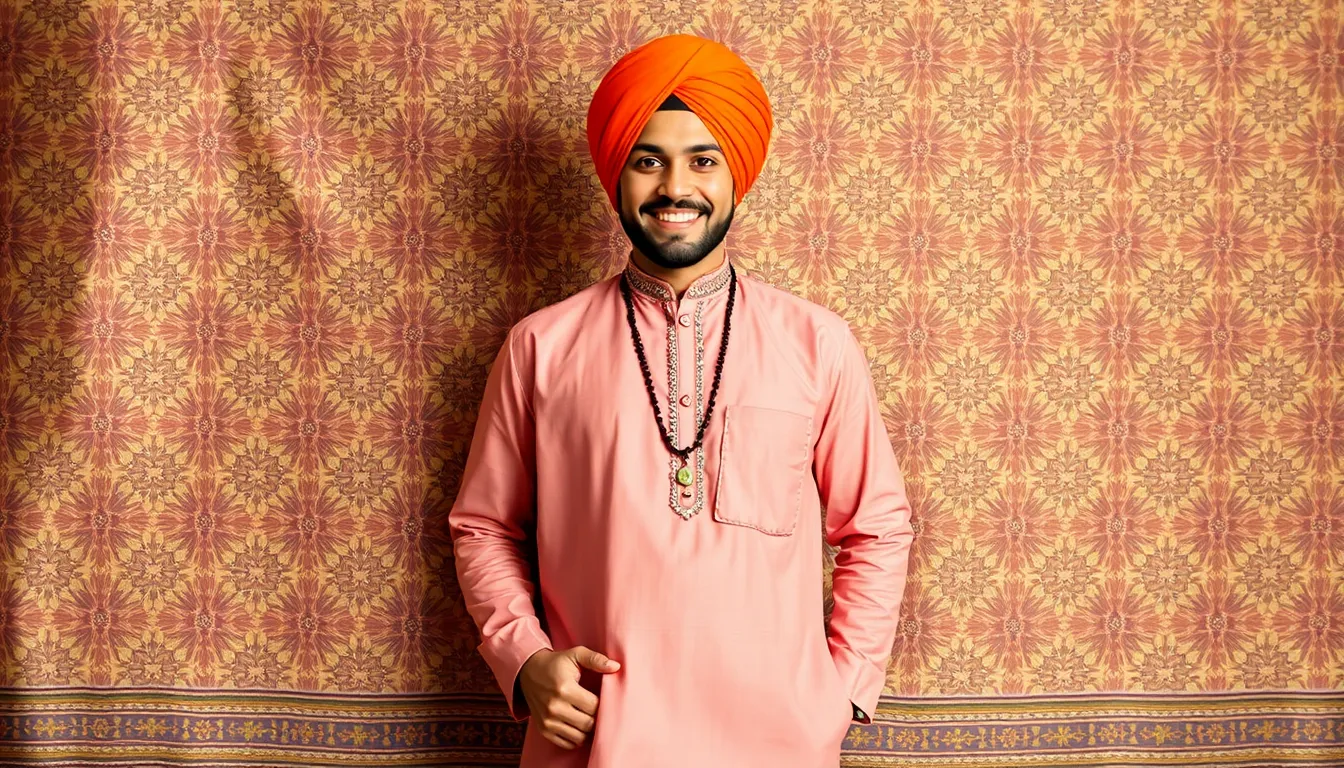
We discover another masterpiece of Indian menswear in the Angrakha, a distinctive cross-over tunic that showcases the sophisticated artistry of traditional Indian tailoring. This wrap-around garment features an asymmetrical closure and cache-coeur style chest design that sets it apart from other traditional outfits.
Historical Background and Evolution
Royal men centuries ago established the Angrakha as a symbol of elegance and elevated status within Indian courts. Originally designed as a long tunic cinched at the waist, this regal garment was traditionally paired with dhoti-style pants or churidar to create complete ceremonial attire.
Regional variations across India influenced the Angrakha’s design elements, with different areas developing unique fabric choices and embellishment techniques. Cultural preferences shaped the garment’s evolution from everyday royal wear into specialized festive and ceremonial attire. Centuries of refinement transformed the basic wrap-around concept into increasingly sophisticated designs that reflected local artistic traditions.
Modern Adaptations of Classic Designs
Contemporary designers like Mayank Modi and luxury labels such as Tarun Tahiliani have revolutionized the traditional Angrakha for modern wardrobes. Advanced fabric technology now incorporates materials like linen, cotton-silk blends, and Italian crepe to enhance comfort while maintaining authentic style elements.
Chikankari embroidery from Lucknow adds heirloom-worthy artistic touches to modern Angrakha kurtas, creating pieces that honor traditional craftsmanship. Color palettes have expanded to include sophisticated options like grey, salmon pink, and gold that appeal to contemporary fashion sensibilities. Party wear and wedding-appropriate versions now feature enhanced embellishments suitable for special occasions.
Fusion styling approaches pair these updated Angrakhas with dhoti pants or straight trousers, creating versatile outfits that blend traditional heritage with current trends.
Styling Tips for Contemporary Wear
Accessorizing your Angrakha with traditional turbans or safas creates a polished, culturally rooted appearance that honors the garment’s royal heritage. Footwear choices like juttis or mojaris complement the outfit’s traditional elements while maintaining authentic styling principles.
Sartorial embellishments including brooches and pocket squares elevate the Angrakha for formal occasions and wedding celebrations. Pairing strategies with slim straight pants or churidars help maintain a modern silhouette that flatters contemporary body types. Stoles and elegant accessories transform the basic Angrakha into sophisticated wedding guest attire or festive occasion wear.
Seasonal fabric selection ensures year-round versatility, with lighter materials for summer events and rich silks for winter functions providing both comfort and traditional authenticity.
Mundu: The Kerala Traditional Lower Garment
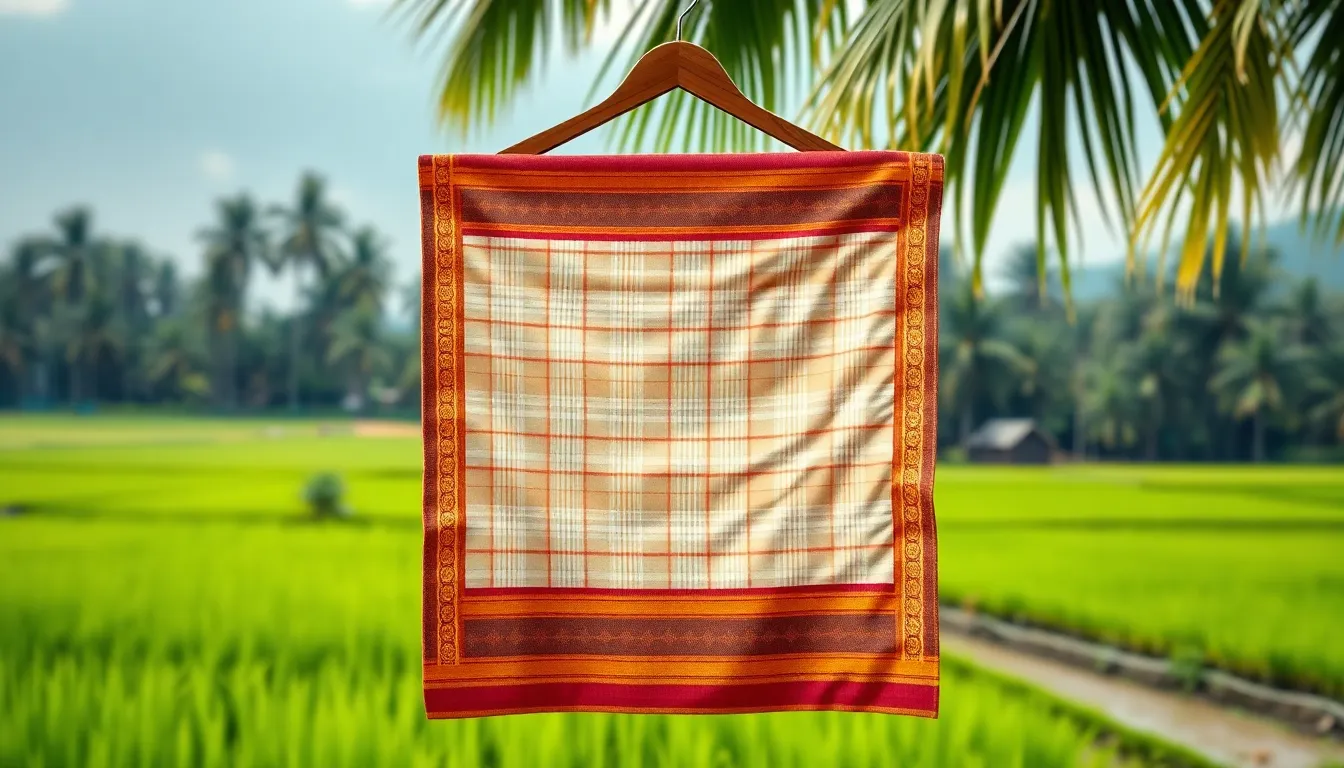
The Mundu stands as Kerala’s most distinctive traditional garment for men, representing a rectangular piece of white or off-white cloth wrapped elegantly around the waist and extending to the ankles. We recognize this garment as culturally important and deeply rooted in Kerala’s rich heritage, offering a unique alternative to the more widely known dhoti across India.
Golden Border Significance
Kasavu borders transform ordinary Mundus into ceremonial masterpieces, featuring intricate golden thread work that carries profound cultural meaning. We observe how this distinctive golden border symbolizes purity, sanctity, prosperity, and cultural heritage throughout Kerala’s traditions. The golden threads reflect Kerala’s reverence for rituals and traditions, signifying wealth and good fortune during life’s most important moments.
Symbolic elements combine beautifully in the Kasavu design, where white fabric represents purity while the golden border symbolizes affluence and the sun’s rays. We appreciate how this combination ties the garment directly to nature and heritage, creating a visual representation of Kerala’s spiritual connection to both simplicity and grandeur. The gold thread border serves as more than decoration, embodying the state’s deep cultural values and aesthetic principles.
Festival and Ceremonial Wearing
Onam celebrations showcase the Kasavu Mundu’s prominence during Kerala’s harvest festival, where traditional attire with golden borders becomes essential for celebrating the state’s cultural identity. We witness how men across Kerala don these elegant garments to honor their heritage during this important festival. Religious ceremonies and formal occasions consistently feature the Mundu as the preferred traditional dress code.
Wedding ceremonies elevate the Kasavu Mundu to its highest ceremonial importance, with grooms typically wearing this traditional attire to emphasize cultural authenticity. We observe how festivals, religious ceremonies, weddings, and formal occasions remain the primary settings where the golden bordered Mundu maintains its cultural significance. The garment’s ceremonial role reinforces Kerala’s commitment to preserving traditional customs across generations.
Difference Between Mundu and Dhoti
Regional specificity distinguishes the Mundu from the broader dhoti category, as this garment remains uniquely tied to Kerala’s cultural context and traditions. We note how the Mundu maintains its characteristic white or off-white fabric with optional gold borders, contrasting with dhoti variations found throughout India. The simplicity of Mundu design and its distinct draping method reflect Kerala’s particular aesthetic preferences.
Cultural context shapes the wearing patterns differently between these garments, with the dhoti serving various regional styles across India while the Mundu stays rooted in Kerala’s exact traditions. We recognize how the Mundu tends toward simpler designs and more standardized draping techniques compared to the diverse dhoti styles found in different Indian states. This distinction helps preserve Kerala’s unique sartorial identity within India’s broader traditional clothing industry.
Pagri: The Traditional Indian Turban
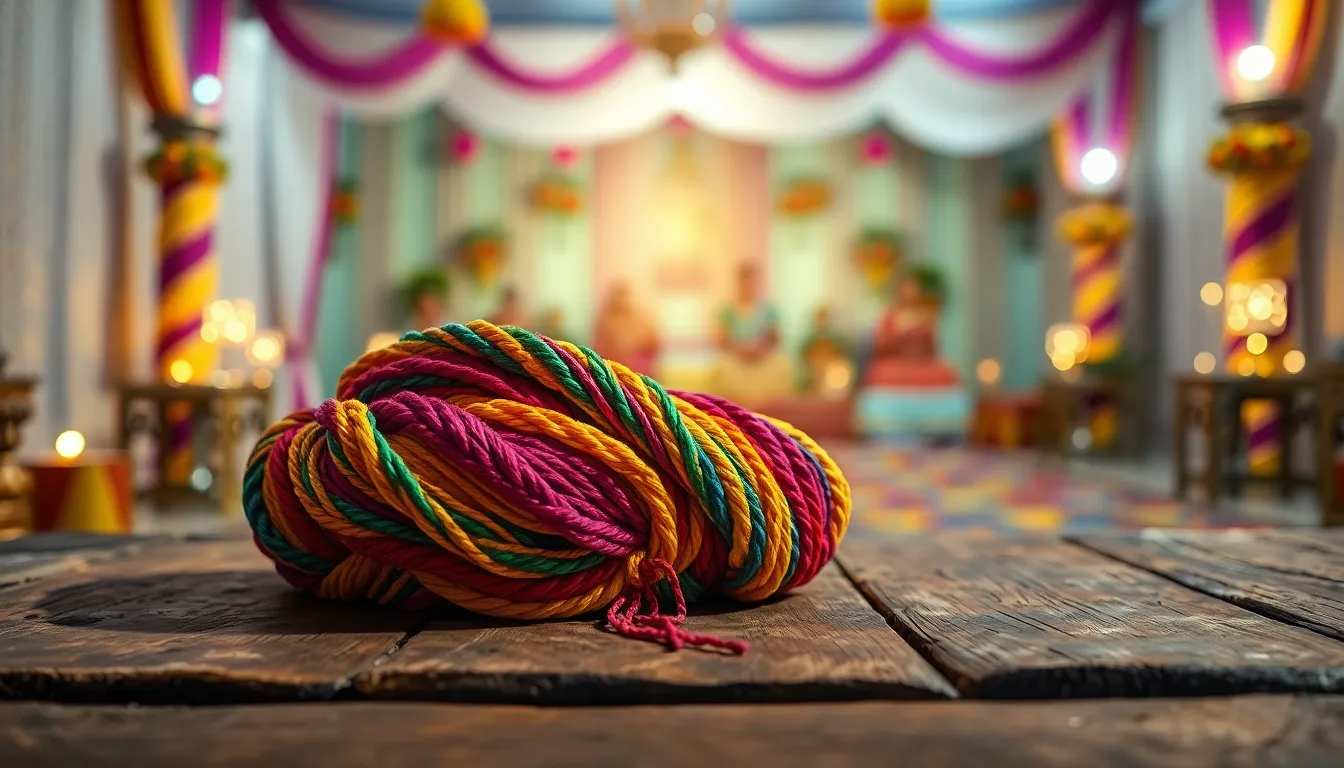
The pagri stands as one of India’s most revered headwear pieces, representing honor, respect, and cultural identity across diverse communities. We recognize this long piece of cloth wrapped around the head as more than functional headgear—it’s a mark of dignity and tradition that connects men to their ancestral heritage.
Regional Turban Styles Across India
Rajasthani Pagri commands attention with its royal lineage, popularized by Rajput rulers and reflecting the vibrant culture of Rajasthan. This colorful style features pre-twisted rope-like wraps that vary throughout different parts of the state, making it a popular choice for grooms during wedding ceremonies.
Marathi Pheta (Safa) presents a uniform wrapping technique across Maharashtra, creating distinctive layers around the head. The signature feature involves a fan-shaped corner positioned at the forehead’s center, adding unique flair that distinguishes it from other regional styles.
Sikh Turbans showcase two primary variations: the “dumalla,” a larger round turban typically worn by Sikh men, and smaller round turbans for everyday wear. Women in Sikh communities also wear more rounded turban versions, maintaining the tradition across genders.
Various other regions throughout India maintain their unique pagri styles, each reflecting local customs and community identity through distinct wrapping methods and decorative elements.
Tying Techniques and Methods
Rajasthani style employs pre-twisted cloth formation, creating rope-like layers that build upon each other for a structured appearance. Masters of this technique wrap the fabric with precise tension to achieve the characteristic royal look associated with this regional style.
Marathi style focuses on neat layering techniques, carefully positioning each fold to create uniform coverage around the head. The process concludes with positioning a fan-shaped flap at the front, requiring skill to achieve the proper angle and proportion.
Traditional tying methods vary significantly based on occasion, social status, and community identity, with each technique carrying cultural significance. We observe that the complexity of wrapping often correlates with the formality of the event and the wearer’s social position.
Color Significance and Occasions
Red and orange turbans dominate wedding celebrations, symbolizing joy and auspiciousness during these festive occasions. Grooms frequently choose these vibrant hues to complement their ceremonial attire and honor traditional symbolism.
White pagris appear during somber occasions or are worn by elders to denote purity and peace. This color choice reflects respect for cultural protocols and demonstrates understanding of appropriate ceremonial dress codes.
Bright patterns and colors accompany festive events, representing vibrancy and celebration throughout various cultural gatherings. These colorful designs often feature intricate motifs that tell stories of regional heritage and community traditions.
We find that color selection extends beyond aesthetics, often indicating caste, community symbolism, and social context within traditional Indian society.
Mojari: The Classic Indian Footwear
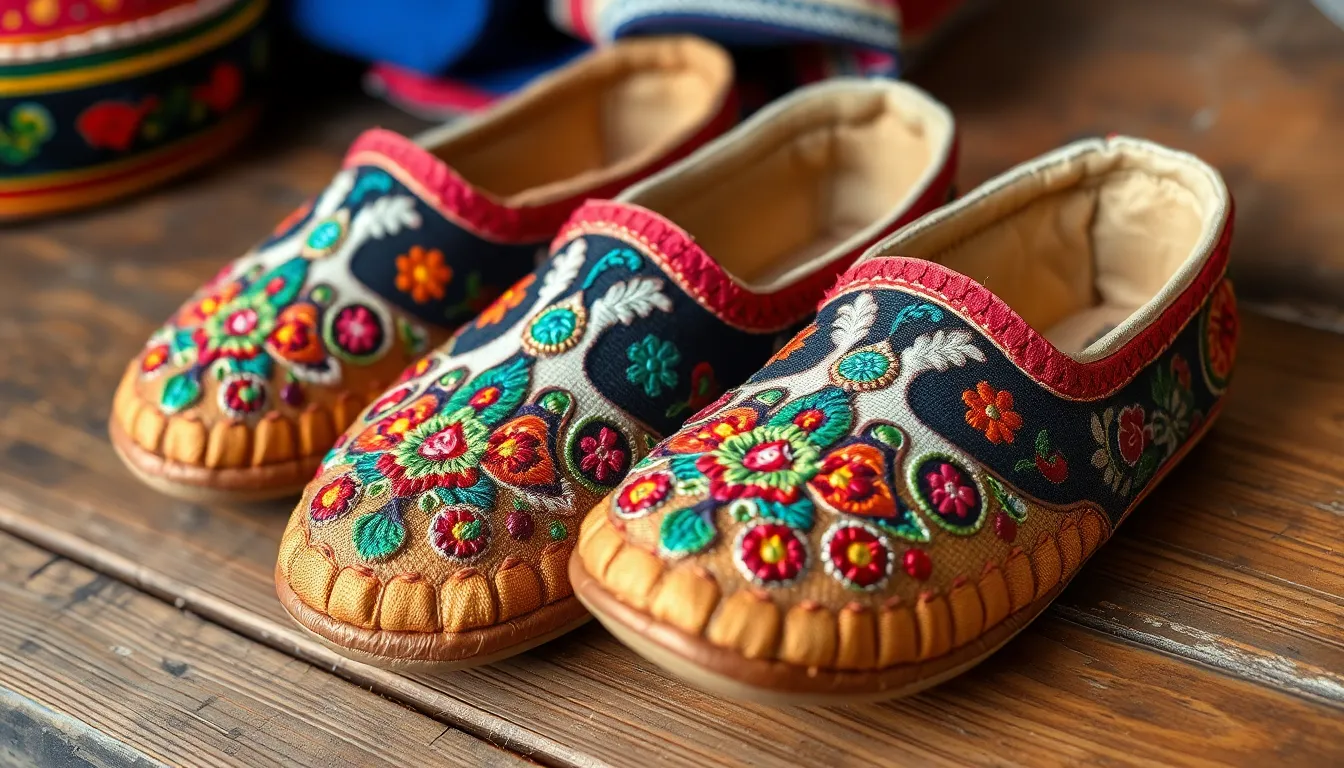
We complete our traditional Indian ensemble with the exquisite mojari, a handcrafted leather shoe that embodies centuries of Indian artistry. This iconic footwear perfectly complements traditional outfits while showcasing the skilled craftsmanship that’s defined Indian culture for generations.
Traditional Craftsmanship and Materials
Artisans from Rajasthan meticulously handcraft each pair of mojaris using time-honored techniques passed down through generations. We witness exceptional skill as craftsmen work with tanned leather, transforming raw materials into elegant footwear through intricate embroidery using threads and beads. The making process involves multiple stages where skilled artisans create unique designs that reflect cultural motifs and regional aesthetics.
Each mojari tells a story through its craftsmanship, with artisans dedicating hours to perfect every stitch and embellishment. We observe how these craftsmen select premium leather materials, ensuring durability while maintaining the traditional aesthetic that makes mojaris so distinctive. The intricate embroidery work often features geometric patterns, floral designs, and cultural symbols that connect wearers to their heritage.
Different Regional Styles
Rajasthan’s mojaris have gained worldwide recognition for their vibrant colors and elaborate embroidery patterns that reflect the state’s royal heritage. We discover fascinating variations across India, where each region has developed distinctive shapes, colors, and embroidery patterns customized to local tastes and customs. Some mojaris feature dramatically curled toes, while others maintain subtle heel heights depending on their regional origins.
Different states have created their own interpretations of this classic footwear, adapting designs to match local cultural preferences and climatic conditions. We notice how northern Indian mojaris often showcase bolder embellishments, while southern variations tend to emphasize comfort and breathability. The diversity in mojari styles demonstrates India’s rich regional craftsmanship traditions and the adaptability of traditional footwear to local needs.
Caring for Leather Mojari
Proper maintenance ensures our mojaris remain beautiful and comfortable for years of wear. We recommend keeping them dry at all times, as moisture can damage the leather and compromise the intricate embroidery work. Gentle cleaning with soft cloths removes dust and maintains their appearance without damaging delicate embellishments.
Regular application of leather conditioners helps maintain the suppleness of the material, preventing cracking and extending the life of our mojaris. We should avoid exposure to rough handling and extreme weather conditions that could damage both the leather and decorative elements. Storing mojaris in a dry, well ventilated area protects them from humidity and ensures they’re ready for our next traditional occasion.
Complete Ensemble: Putting Together Traditional Outfits
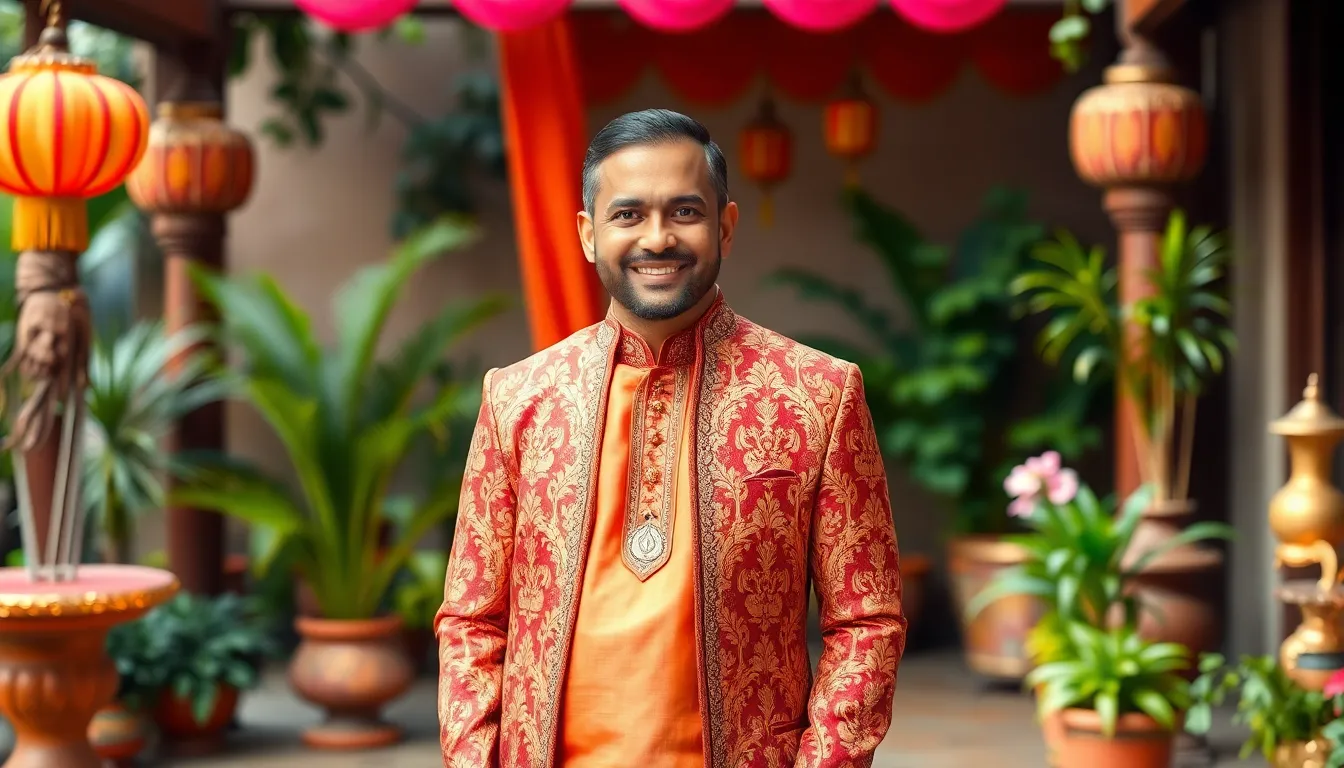
Mastering the art of traditional Indian menswear requires understanding how each element works harmoniously together. We’ll explore the essential aspects of creating polished, culturally authentic looks that honor heritage while reflecting personal style.
Coordinating Colors and Patterns
Color coordination serves as the foundation for any stunning traditional ensemble. We recommend choosing hues based on your skin tone, with darker shades like navy, burgundy, and emerald green complementing deeper complexions beautifully. Lighter skin tones shine in pastels and softer shades that enhance natural radiance without overwhelming the wearer.
Pattern mixing adds visual interest when done thoughtfully. Pairing richly embroidered brocade jackets with solid-colored kurtas creates sophisticated contrast that draws the eye. Neutrals such as black, gray, and beige maintain elegance while offering versatility across multiple occasions and seasons.
Occasion-appropriate color selection ensures cultural sensitivity and style harmony. Luxurious silks and brocades in jewel tones work perfectly for weddings and grand celebrations. Subtle colors paired with lighter fabrics suit daytime events and casual gatherings more appropriately.
Seasonal Considerations for Traditional Wear
Summer and daytime events call for breathable, lightweight fabrics that prioritize comfort without sacrificing style. Cotton, linen, and cotton-silk blends offer the perfect balance of tradition and practicality during warmer months. These materials allow air circulation while maintaining the sophisticated appearance expected in traditional wear.
Winter and evening occasions demand richer fabric choices that provide warmth and opulence. Silk, brocade, and velvet create stunning sherwanis and bandhgalas that make powerful style statements. These luxurious materials also photograph beautifully under evening lighting conditions.
Layering techniques enhance both warmth and visual appeal during cooler weather. Nehru jackets and bandhgalas serve dual purposes, adding sophistication while providing practical temperature control. Strategic layering allows for easy adjustment as temperatures change throughout extended celebrations.
Mixing Traditional with Modern Elements
Contemporary fusion styles offer exciting opportunities to honor heritage while embracing current trends. Pairing kurtas with fitted churidars creates a refined silhouette that works for both traditional and modern settings. Jeans combined with elegant kurtas deliver casual yet ethnic looks perfect for cultural events and festivals.
Modern layering techniques transform classic garments into versatile wardrobe staples. Traditional kurtas paired with contemporary blazers or asymmetrical jackets create unique styling options. These combinations allow seamless transitions from casual daytime activities to formal evening events.
Statement accessories bridge traditional and modern aesthetics effortlessly. Modern footwear styles complement classic garments while adding contemporary flair. Minimalist jewelry provides subtle enhancement without competing with intricate traditional embellishments, creating balanced looks that feel both timeless and current.
Conclusion
Traditional Indian menswear represents far more than just clothing – it embodies our cultural identity and artistic heritage that spans millennia. From the ancient dhoti to the regal sherwani each garment tells a story of craftsmanship and tradition that continues to evolve with modern times.
We’ve witnessed how these timeless pieces seamlessly blend with contemporary fashion creating versatile looks for today’s men. Whether you’re attending a wedding celebration or cultural festival these traditional outfits offer unmatched elegance and cultural authenticity.
The beauty of Indian traditional wear lies in its diversity and adaptability. By understanding the significance behind each garment and mastering the art of styling we can honor our heritage while expressing our personal style with confidence and pride.
Frequently Asked Questions
What is the significance of traditional Indian menswear?
Traditional Indian menswear represents thousands of years of cultural heritage and artistic craftsmanship. These garments carry deep spiritual and cultural meanings, connecting men to their roots while showcasing regional diversity. The resurgence of traditional wear reflects a growing appreciation for cultural identity, with men embracing these timeless pieces for weddings, festivals, and formal occasions.
What is a dhoti and why is it important in Indian culture?
A dhoti is India’s most ancient garment for men, dating back over 5,000 years to the Indus Valley Civilization. It’s a rectangular piece of cloth wrapped around the waist and legs. The dhoti holds spiritual significance in religious texts, depicted as sacred attire worn by deities and sages, symbolizing purity and cultural continuity.
How versatile is a kurta for different occasions?
Kurtas are extremely versatile, suitable for both casual and formal settings. Short kurtas work well for everyday wear when paired with jeans or chinos, while long kurtas made from rich fabrics like silk are perfect for formal events. They can be styled with traditional pajamas, churidars, or modern trousers to suit various occasions.
When should I wear a sherwani?
Sherwanis are ideal for weddings, formal ceremonies, and cultural celebrations. This elegant long coat-like garment with mandarin collar represents the pinnacle of Indian formal menswear. Made from luxurious fabrics with intricate embroidery, sherwanis are particularly popular among grooms for their regal appearance and cultural authenticity.
What’s the difference between a dhoti and a lungi?
While both are traditional lower garments, a dhoti is draped and tucked in specific ways with regional variations, while a lungi is a simpler wrap-around skirt tied at the waist. Lungis are popular in South India, made primarily of cotton for breathability, and come in casual and formal silk versions.
What is a Bandhgala jacket?
A Bandhgala is India’s most sophisticated formal jacket, combining British tailoring with traditional Indian aesthetics. It features a distinctive closed stand-up collar (Nehru collar) and vertical button lines. Perfect for weddings, receptions, and cultural ceremonies, it represents royal heritage and refined elegance in formal Indian menswear.
How do I style an Angrakha?
An Angrakha is a cross-over tunic with royal heritage. Style it with traditional turbans and juttis for formal occasions, or pair with modern trousers for contemporary looks. Choose seasonal fabrics – lighter materials for summer and richer fabrics for winter. The key is balancing traditional elements with modern accessories.
What makes Kerala’s Mundu special?
The Mundu is Kerala’s distinctive white or off-white rectangular cloth wrapped around the waist. The special Kasavu version features intricate golden borders symbolizing purity and prosperity. It’s prominently worn during Onam festival and wedding ceremonies, representing Kerala’s unique cultural identity within India’s traditional clothing landscape.
What is the cultural significance of wearing a pagri?
A pagri (turban) represents honor, respect, and cultural identity across Indian communities. Different regions have unique styles – Rajasthani Pagris are vibrant and royal, while Marathi Phetas have fan-shaped corners. Colors carry meaning: red/orange for weddings, white for somber occasions, reflecting cultural protocols and social status.
How should I care for mojari footwear?
Mojaris require gentle care to maintain their handcrafted beauty. Keep them dry and away from moisture, clean gently with a soft brush, and condition the leather regularly. Store in breathable bags and avoid harsh chemicals. Proper maintenance ensures these artisanal shoes retain their intricate embroidery and cultural motifs for years.
How do I create a complete traditional ensemble?
Coordinate colors and patterns thoughtfully, selecting hues that complement your skin tone and occasion. Mix patterns carefully for visual interest without overwhelming the look. Choose seasonal fabrics – breathable materials for summer, richer fabrics for winter. Complete the ensemble with appropriate accessories like turbans, stoles, and traditional footwear.
Can I mix traditional and modern elements?
Yes, modern fusion styles are increasingly popular. Pair traditional kurtas with contemporary jeans, or wear Bandhgala jackets with modern trousers. The key is maintaining cultural authenticity while adapting to current fashion trends. Statement accessories can bridge traditional and modern aesthetics, creating unique, personalized looks that honor heritage while embracing contemporary style.

